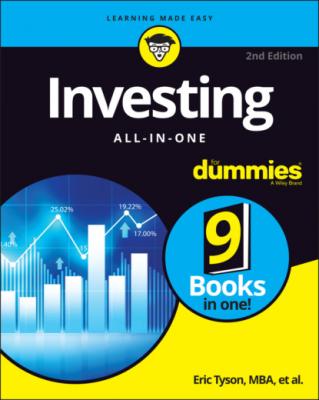Investing All-in-One For Dummies. Eric Tyson
Чтение книги онлайн.
Читать онлайн книгу Investing All-in-One For Dummies - Eric Tyson страница 45
 name (or symbol depending on the source). Stock symbols are the language of stock investing, and you need to use them in all stock communications, from getting a stock quote at your broker’s office to buying stock over the internet.
name (or symbol depending on the source). Stock symbols are the language of stock investing, and you need to use them in all stock communications, from getting a stock quote at your broker’s office to buying stock over the internet.
Dividend
Dividends (shown under the “Div” column in Table 1-1) are basically payments to owners (stockholders). If a company pays a dividend, it’s shown in the dividend column. The amount you see is the annual dividend quoted for one share of that stock. If you look at LowDownInc (LDI) in Table 1-1, you can see that you get $2.35 as an annual dividend for each share of stock that you own. Companies usually pay the dividend in quarterly amounts. If you own 100 shares of LDI, the company pays you a quarterly dividend of $58.75 ($235 total per year). A healthy company strives to maintain or upgrade the dividend for stockholders from year to year. (Additional dividend details are discussed later in this chapter.)
The dividend is very important to investors seeking income from their stock investments. For more about investing for income, see Chapter 3 in Book 3. Investors buy stocks in companies that don’t pay dividends primarily for growth. For more information on growth stocks, see Chapter 2 in Book 3.
Volume
Normally, when you hear the word “volume” on the news, it refers to how much stock is bought and sold for the entire market: “Well, stocks were very active today. Trading volume at the New York Stock Exchange hit 2 billion shares.” Volume is certainly important to watch because the stocks that you’re investing in are somewhere in that activity. For the “Vol” column in Table 1-1, though, the volume refers to the individual stock.
Volume tells you how many shares of that particular stock were traded that day. If only 100 shares are traded in a day, then the trading volume is 100. SHC had 3,143 shares change hands on the trading day represented in Table 1-1. Is that good or bad? Neither, really. Usually the business news media mention volume for a particular stock only when it’s unusually large. If a stock normally has volume in the 5,000 to 10,000 range and all of a sudden has a trading volume of 87,000, then it’s time to sit up and take notice.
The main point to remember is that trading volume that is far in excess of that stock’s normal range is a sign that something is going on with that company. It may be negative or positive, but something newsworthy is happening with that company. If the news is positive, the increased volume is a result of more people buying the stock. If the news is negative, the increased volume is probably a result of more people selling the stock. What are typical events that cause increased trading volume? Some positive reasons include the following:
Good earnings reports: The company announces good (or better-than-expected) earnings.
A new business deal: The firm announces a favorable business deal, such as a joint venture, or lands a big client.
A new product or service: The company’s research and development department creates a potentially profitable new product.
Indirect benefits: The business may benefit from a new development in the economy or from a new law passed by Congress.
Bad earnings reports: Profit is the lifeblood of a company. When its profits fall or disappear, you see more volume.
Governmental problems: The stock is being targeted by government action, such as a lawsuit or a Securities and Exchange Commission (SEC) probe.
Liability issues: The media report that the company has a defective product or similar problem.
Financial problems: Independent analysts report that the company’s financial health is deteriorating.
Yield
In general, yield is a return on the money you invest. However, in the stock tables, yield (“Yld” in Table 1-1) is a reference to what percentage that particular dividend is of the stock price. Yield is most important to income investors. It’s calculated by dividing the annual dividend by the current stock price. In Table 1-1, you can see that the yield du jour of ValueNowInc (VNI) is 4.5 percent (a dividend of $1 divided by the company’s stock price of $22). Notice that many companies report no yield; because they have no dividends, their yield is zero.
P/E
In the P/E ratios reported in stock tables, price refers to the cost of a single share of stock. Earnings refers to the company’s reported earnings per share as of the most recent four quarters. The P/E ratio is the price divided by the earnings. In